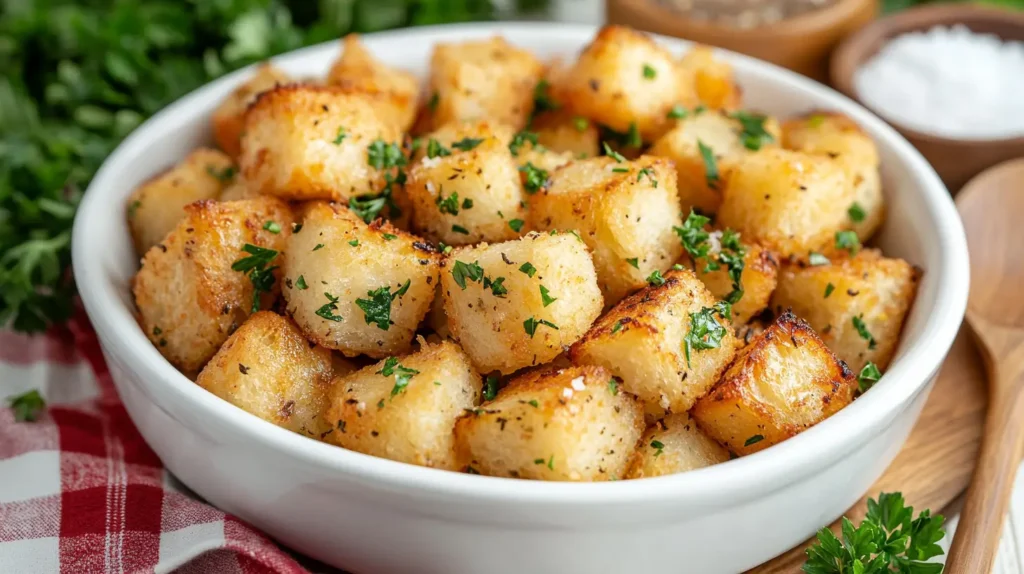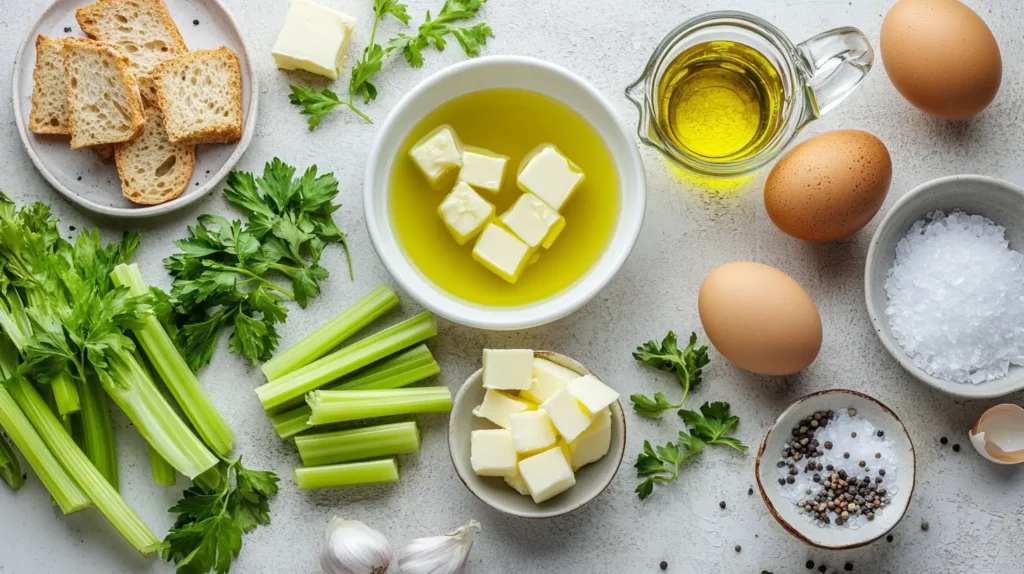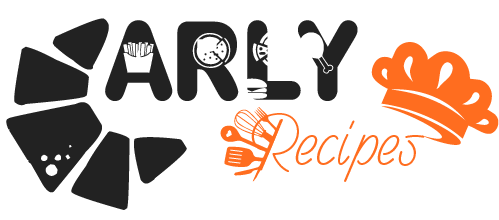Gluten free stuffing is a flavorful and satisfying side dish made without wheat-based ingredients, ensuring it meets the dietary needs of those avoiding gluten. Traditionally served at dinner, especially during festive meals, this version uses gluten-free bread or grain alternatives as the base. Its texture and taste remain similar to traditional stuffing, making it a versatile choice for everyone at the table.

Table of Contents
Key Ingredients
Here are some essential ingredients to consider:
- Gluten-free bread: Choose pre-packaged gluten-free loaves or bake your own
- Broth: Use vegetable, chicken, or turkey broth for moistness
- Vegetables: Celery, onions, and carrots are classic additions
- Herbs and spices: Rosemary, thyme, sage, and parsley add depth to the flavor
- Optional extras: Dried fruits like cranberries, nuts, or even sausage for a richer stuffing

How to Make it at Home
Making gluten free stuffing at home is simple and rewarding, allowing you to control the quality of ingredients and adapt it to your taste. Start by choosing the right gluten-free bread, which forms the base of the stuffing. Cut the bread into cubes and toast it lightly to create a sturdy texture that can absorb flavors.
Next, sauté vegetables like onions, celery, and carrots in butter or olive oil until softened. Combine the toasted bread cubes with the sautéed vegetables, then add fresh herbs such as sage, thyme, and rosemary for a traditional flavor profile. Gradually pour warm broth over the mixture, stirring gently to moisten the bread without making it soggy.
Transfer the stuffing to a baking dish and bake it at 350°F (175°C) until the top is golden brown and slightly crisp. This easy process results in a dish that’s perfect for any dinner, whether it’s a special occasion or a cozy family meal.
Popular Recipes
- Classic Herb Stuffing: This traditional recipe features gluten-free bread, fresh sage, thyme, and parsley, making it a timeless favorite.
- Sausage and Apple Stuffing: A heartier version with gluten-free sausage, diced apples, and savory herbs, offering a balance of sweetness and saltiness.
- Vegetarian Mushroom Stuffing: Perfect for plant-based eaters, this variation uses mushrooms, vegetable broth, and gluten-free bread for a rich and earthy flavor.
- Cranberry and Pecan Stuffing: A festive option combining dried cranberries, chopped pecans, and gluten-free bread, adding a touch of sweetness and crunch.
Gluten Free Stuffing for Different Occasions
It is a versatile side dish that fits seamlessly into a variety of dinner settings. For Thanksgiving and Christmas, it’s a must-have on the table, complementing dishes like turkey and roasted vegetables. Its warm, hearty flavors make it an excellent choice for cold-weather gatherings.
Beyond holidays, gluten free stuffing can be included in casual family dinners or even potlucks. Pair it with roasted chicken, pork chops, or grilled fish for a balanced and satisfying meal. The ability to adapt the ingredients makes it suitable for different themes or flavors, ensuring it can shine at any occasion.
Tips for Buying Gluten Free Stuffing
When buying ingredients for gluten free stuffing, it’s important to read labels carefully to ensure the product is truly gluten-free. Many bread and seasoning mixes may contain hidden gluten, so look for certified gluten-free labels to guarantee safety.
Consider these tips:
- Opt for brands that specialize in gluten-free products, as they are less likely to contain cross-contaminants.
- Check for added preservatives or artificial flavors that might affect the overall taste of the stuffing.
- If purchasing pre-made stuffing, review customer reviews to confirm the product’s quality and flavor.
These simple steps will help you select the best ingredients for your stuffing, ensuring a delicious result every time.
Challenges and Solutions in Making it
Creating the perfect gluten free stuffing can come with challenges, but they’re easy to overcome with the right approach. One common issue is achieving the ideal texture, as gluten-free bread tends to be more delicate. Toasting the bread cubes before mixing helps maintain their structure during baking.
Another challenge is ensuring the stuffing doesn’t become too dry or overly soggy. Gradually adding broth while stirring allows you to monitor the moisture level and achieve the right balance. Additionally, if the flavor feels lacking, increase the amount of fresh herbs or add ingredients like garlic and onions to enhance the dish.
By addressing these challenges, you can create a stuffing that’s both delicious and satisfying, ensuring that it becomes a staple at your dinner table.
Storage and Reheating Tips
Proper storage and reheating of gluten free stuffing ensure its flavor and texture remain intact. Once cooked, allow the stuffing to cool completely before transferring it to an airtight container. Store it in the refrigerator for up to three days or freeze it for longer-term use, up to three months.
When reheating, use a low oven temperature (around 300°F or 150°C) to avoid drying out the dish. Cover the stuffing with foil to retain moisture, and if necessary, add a small amount of broth to refresh its texture. For smaller portions, the microwave is a convenient option, though it may not produce the same crispness as the oven.
Flavor Enhancements
To elevate the taste of gluten free stuffing, consider adding complementary ingredients that amplify its flavor. Fresh herbs like rosemary, sage, and thyme provide a classic, aromatic profile, while spices like paprika or nutmeg add a hint of warmth.
Incorporating umami-rich ingredients, such as mushrooms, sun-dried tomatoes, or Parmesan cheese, can create a more robust taste. A splash of balsamic vinegar or a squeeze of lemon juice at the end of cooking introduces a bright, tangy note that balances the dish.
Regional Variations of Gluten Free Stuffing
In contrast, Mediterranean-inspired stuffing might feature gluten-free bread, olives, sun-dried tomatoes, and feta cheese, providing a lighter, tangy flavor. For an Asian twist, rice-based stuffing with ginger, soy-free tamari, and scallions adds a unique flair.
How to Use Gluten Free Stuffing in Other Recipes
It is versatile and can be repurposed into other dishes, reducing food waste and adding creativity to your meals. Use leftover stuffing as a filling for roasted vegetables, such as bell peppers or squash, for a wholesome and satisfying side dish.
It can also be pressed into patties and pan-fried for a crispy, flavorful alternative to traditional cakes or fritters. Additionally, layer stuffing in a casserole with leftover meat and vegetables, topping it with cheese for a quick and comforting bake.
Kid-Friendly Gluten Free Stuffing Ideas
Creating kid-friendly gluten free stuffing involves simplifying the flavors and adding familiar ingredients that children enjoy. Swap out strong herbs for milder options like parsley, and consider including sweet elements such as diced apples or raisins to appeal to young palates.
Mini muffin-sized portions of stuffing can make the dish more fun and approachable for kids. Adding cheese or small pieces of gluten-free sausage can further enhance its appeal. Involving children in the preparation process, like tearing bread cubes or mixing ingredients, can also make them more excited to try the dish.
Budget-Friendly Gluten Free Stuffing Options
Making gluten free stuffing on a budget is entirely possible by choosing cost-effective ingredients and planning ahead. Use homemade gluten-free bread or day-old store-bought options, as they’re often less expensive. Opt for seasonal vegetables like onions and carrots, which are both affordable and flavorful.
Bulk purchases of herbs or using dried options can save money without sacrificing taste. Additionally, consider making your own broth using vegetable scraps or chicken bones, which not only reduces waste but also lowers costs.
Best Tools and Equipment for Making Gluten Free Stuffing
Having the right tools can simplify the process of making gluten free stuffing. A sharp knife is essential for chopping vegetables and bread cubes evenly. Use a large mixing bowl to combine ingredients thoroughly without spillage.
A sturdy baking dish ensures even cooking, while parchment paper or a non-stick spray prevents sticking. For toasting bread cubes, a baking sheet with a rim works best. If you’re making a large batch, consider a stand mixer with a paddle attachment to save time on mixing.
Tips for Perfectly Moist Gluten Free Stuffing
Achieving perfectly moist gluten free stuffing requires attention to detail during preparation. Start by toasting the bread cubes lightly; this step helps them absorb liquid without becoming overly mushy. When adding broth, do so gradually, stirring after each addition to evenly distribute moisture.
Cover the dish with foil while baking to trap steam, then uncover it during the last few minutes to create a crisp top layer. Using fresh herbs and butter also enhances moisture and flavor, ensuring your stuffing is tender and delicious.
FAQs
Does Stove Top Stuffing Have Gluten in It?
Yes, most Stove Top Stuffing varieties contain gluten as they are typically made with wheat-based bread. Gluten is a primary component in traditional stuffing mixes, so they are not safe for individuals with gluten intolerance or celiac disease.
Can Gluten-Free People Eat Stuffing?
Yes Many recipes and pre-packaged options are tailored for gluten-free diets, ensuring safety and taste for those avoiding gluten. Always check ingredient labels to confirm the dish is gluten-free.
Are Sweet Potatoes Gluten-Free?
Yes, sweet potatoes are naturally gluten-free. They are a versatile and nutritious option for those avoiding gluten and can be used as a side dish or incorporated into recipes. When preparing sweet potatoes, ensure that additional ingredients, such as seasonings or sauces, are also gluten-free to avoid cross-contamination.
What Can I Eat Instead of Stuffing?
- Rice pilaf: A flavorful mix of rice, vegetables, and spices.
- Quinoa salad: Packed with protein and adaptable to various flavors.
- Roasted vegetables: A simple, hearty side dish.
- Mashed potatoes: A classic and gluten-free alternative.
Conclusion
Gluten free stuffing is more than just a dietary alternative; it’s a versatile, delicious dish that enhances any dinner. By choosing the right ingredients, mastering preparation techniques, and exploring creative variations, you can create a stuffing that delights every guest at the table.
For more delicious options, try our French Toast Pancakes, Sourdough French Toast, or learn about Hawaiian Rolls vs. Brioche to complement your meal!
